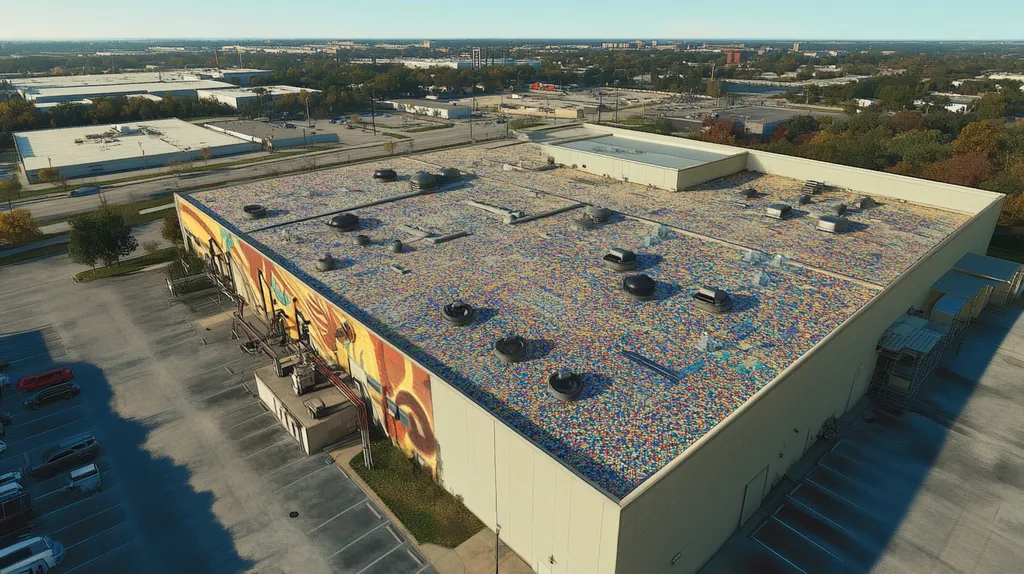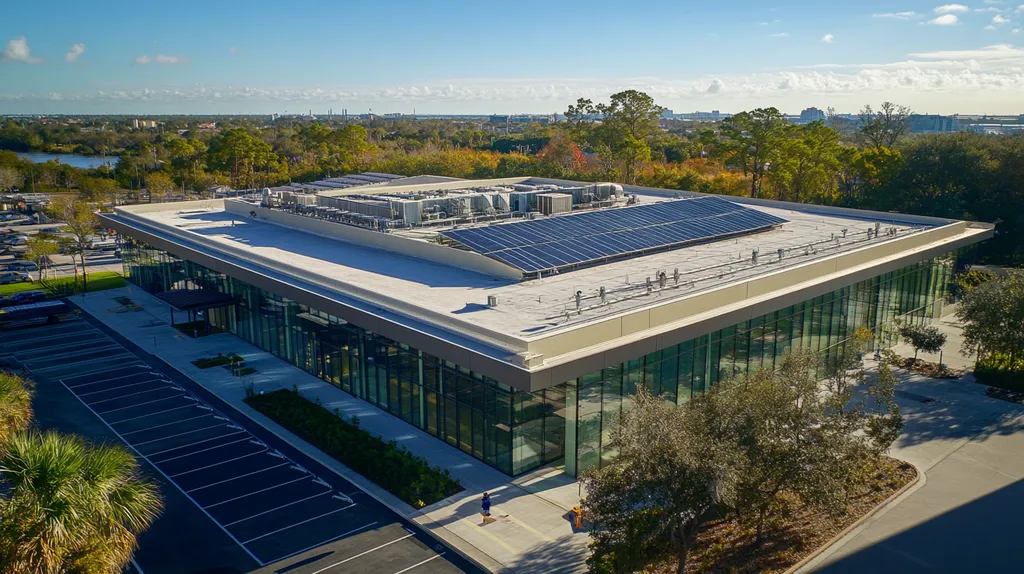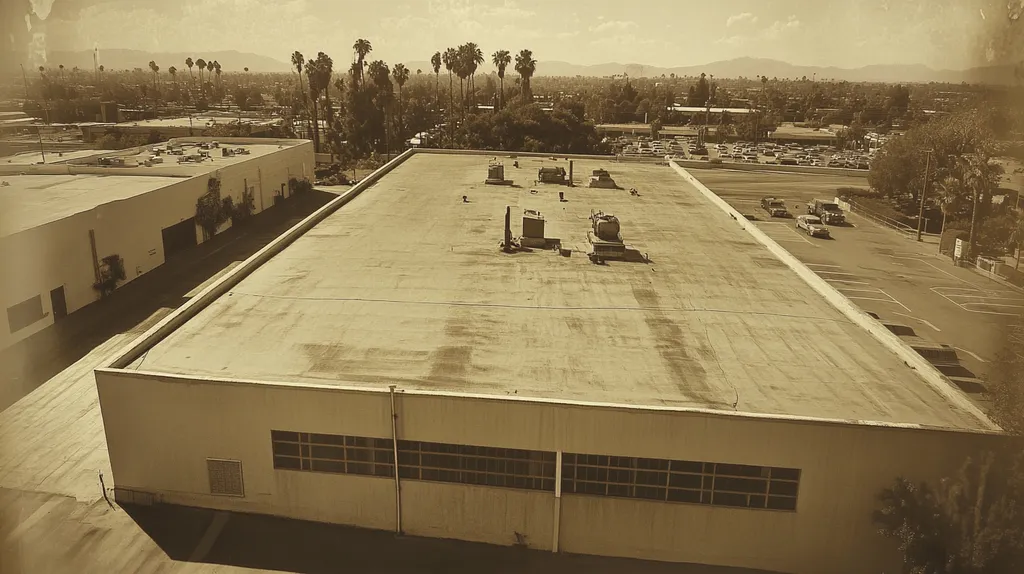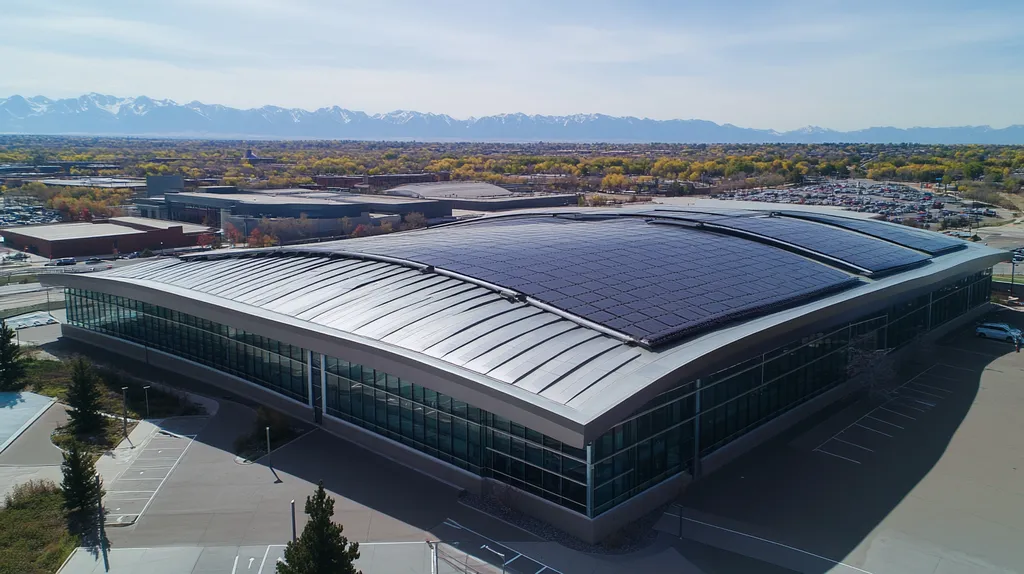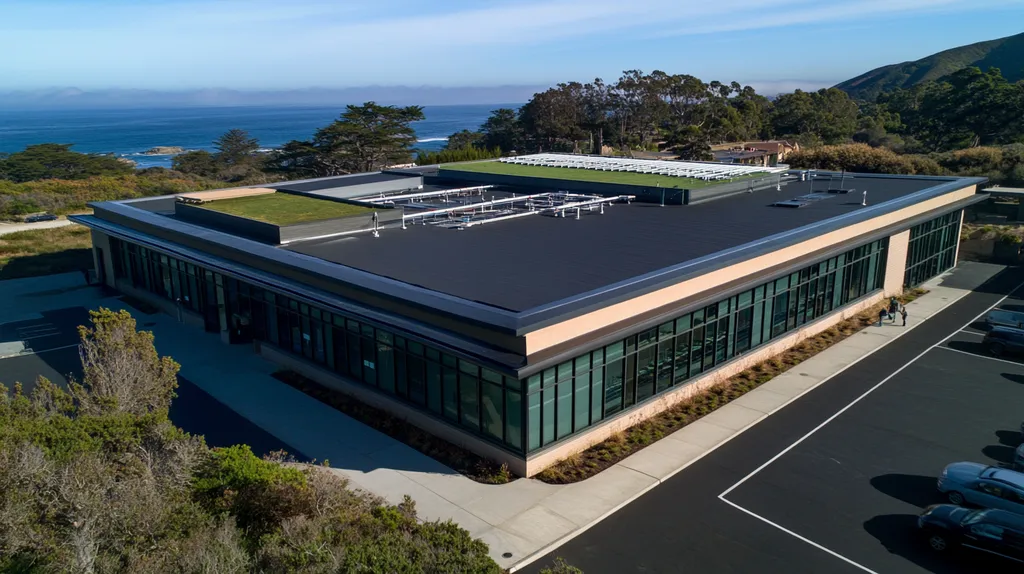In the past decade, extreme weather events have caused over $1 trillion in damage to industrial facilities, with roof failures accounting for 40% of these losses. As climate patterns intensify, traditional roofing approaches are proving inadequate against unprecedented environmental stresses.
Modern industrial roofing systems must withstand hurricane-force winds, extreme temperature fluctuations, and torrential rainfall while protecting millions in assets and operations beneath.
This comprehensive guide examines the critical elements that enable industrial roofs to combat severe weather conditions, from material selection to installation techniques and maintenance strategies.
SECTION 1: THE BASICS EXPLAINED
Extreme weather events pose an escalating threat to industrial roofing systems, with incidents nearly doubling in frequency over the past two decades. These intensifying patterns of severe storms, temperature extremes, and atmospheric pressure changes demand increasingly resilient roofing solutions. Property owners and facility managers must understand how modern industrial roofing systems combat these challenges to protect their assets and maintain operational continuity.
What It Is (In Plain Language)
Industrial roofing systems represent the most robust category of commercial roofing, engineered specifically to protect large-scale facilities from severe environmental stresses. These systems typically span vast areas, often covering tens of thousands of square feet, and must maintain their integrity under much greater loads than residential or light commercial roofs.
Modern industrial roofs utilize advanced materials like thermoplastic polyolefin (TPO), ethylene propylene diene monomer (EPDM), and reinforced PVC membranes. These materials offer superior resistance to UV radiation, chemical exposure, and extreme temperature fluctuations.
The structural components include robust decking, multiple insulation layers, and sophisticated drainage systems. This layered approach creates a comprehensive barrier against environmental threats while supporting necessary mechanical equipment.
When properly specified and installed, these systems can deliver 25-30 years of reliable service. However, this longevity depends heavily on selecting appropriate materials and maintaining regular inspection schedules.
Why It Matters (To Your Building)
Between 2000 and 2019, more than 7,300 extreme weather events occurred worldwide, representing a dramatic increase from previous decades. This surge in severe weather directly impacts the integrity and performance of industrial roofing systems. (source: Beacon Bits)
Roof failure during extreme weather can trigger catastrophic consequences, including complete production shutdowns, inventory damage, and equipment destruction. Even minor compromises in roof integrity can lead to significant energy losses and accelerated deterioration of building components.
Beyond protecting assets, industrial roofs play a crucial role in facility energy management. Poor thermal performance can increase HVAC costs by 25-35%, directly impacting operational budgets.
Industrial roofs must also comply with increasingly stringent building codes and insurance requirements, particularly in regions prone to severe weather events.
How It Works
Industrial roofing systems employ multiple defensive strategies to combat extreme weather. The primary membrane layer provides waterproofing while specialized coatings reflect solar radiation and resist chemical degradation.
Beneath the surface, structural components work together to distribute loads and maintain stability. Advanced fastening systems secure roofing materials against high winds, while carefully engineered slope designs prevent water accumulation.
Strategic insulation placement manages thermal transfer and prevents condensation formation. This helps maintain stable interior conditions while reducing energy consumption.
Modern industrial roofs also incorporate smart drainage solutions that can handle sudden deluges without overwhelming the system. These features work in concert with expansion joints and reinforcement points to accommodate building movement during temperature extremes.
The entire system relies on proper installation techniques and regular maintenance to maintain its protective capabilities. Scheduled inspections help identify and address potential weaknesses before they develop into significant problems.
SECTION 2: PRACTICAL APPLICATIONS
Industrial facilities face mounting challenges from severe weather events, with damage from extreme conditions causing millions in losses annually. The frequency of severe weather events has nearly doubled since 1980, placing unprecedented demands on roofing systems. Understanding how industrial roofs perform in real-world applications is crucial for facility managers seeking to protect their assets and maintain operational continuity.
Common Uses & Examples
Modern industrial roofs serve multiple critical functions beyond basic weather protection. Manufacturing facilities often employ reinforced membrane systems capable of supporting heavy mechanical loads while resisting extreme temperature fluctuations.
Food processing plants frequently utilize TPO or PVC systems that offer superior chemical resistance and meet stringent sanitation requirements. These materials prevent bacterial growth while maintaining thermal efficiency.
Distribution centers commonly implement multi-ply systems designed to support vast expanses without compromising structural integrity. These installations often incorporate enhanced drainage systems to prevent water accumulation during severe storms.
Storage facilities typically employ specialized coatings and membranes that reflect solar radiation while protecting sensitive inventory. These systems often feature advanced vapor barriers to prevent moisture-related damage to stored goods.
When You Need It Most
Between 2000 and 2019, more than 7,300 extreme weather events occurred worldwide, nearly doubling the frequency from previous decades. This dramatic increase underscores the critical importance of timing in roof installation and maintenance. (source: Beacon Engineering)
Industrial facilities must prioritize roofing upgrades before peak stress periods. Hurricane-prone regions require reinforced systems installed well before storm season, while facilities in northern climates need enhanced load-bearing capacity before winter.
Emergency repairs during extreme weather events can cost up to five times more than scheduled maintenance. Planning installations during optimal weather conditions ensures proper curing and adhesion of materials.
Regular inspections become particularly crucial during seasonal transitions when temperature fluctuations place additional stress on roofing components.
Interactions With Other Systems
Industrial roofs function as integrated components within larger facility systems. The interface between roofing and HVAC equipment requires careful consideration of load distribution and thermal performance.
Drainage systems must coordinate seamlessly with roof slope and membrane configuration. Proper integration prevents water accumulation while protecting structural elements from moisture intrusion.
Building automation systems often incorporate rooftop sensors for monitoring structural integrity and environmental conditions. These systems help facility managers anticipate maintenance needs and prevent catastrophic failures.
Energy management systems rely heavily on roofing performance. Properly integrated insulation and reflective surfaces can reduce HVAC loads by up to 30%, highlighting the importance of system-wide coordination.
SECTION 3: KEY TERMINOLOGY DECODED
Industrial roofing terminology can make the difference between robust protection and catastrophic failure during extreme weather events. Research indicates that misunderstanding technical specifications leads to 40% of premature roof failures. For facility managers and property owners, decoding these critical terms isn’t just about communication – it’s about protecting millions in assets and preventing operational disruptions.
Essential Terms Explained
R-value stands at the forefront of thermal protection, measuring insulation effectiveness. Higher values indicate better resistance to heat transfer, with modern industrial facilities typically requiring R-30 or greater for optimal performance during temperature extremes.
Wind uplift resistance ratings define a roof’s ability to withstand storm conditions. These ratings, measured in pounds per square foot (psf), must match local weather patterns and building height requirements to prevent membrane separation during severe weather.
Membrane thickness, measured in mils, directly impacts durability and puncture resistance. While standard commercial roofs might use 45-mil membranes, industrial facilities often require 60-mil or thicker materials to handle extreme conditions.
Load capacity determines how much weight the roof can safely support, including equipment, snow, and maintenance traffic. This measurement combines dead loads (permanent weight) and live loads (temporary weight) to establish safe operating parameters.
Industry Jargon Translated
Fully adhered systems bond the entire membrane to the substrate, providing superior wind resistance. This differs from mechanically fastened systems, which secure the membrane at specific points and may be more vulnerable to extreme conditions.
Vapor barriers prevent moisture from migrating through the roof assembly. Their performance is measured in perms, with lower numbers indicating better vapor resistance – crucial for facilities in humid climates or those housing moisture-sensitive operations.
Roof recovery involves installing new materials over existing ones, while roof replacement strips everything to the deck. Understanding these options helps facility managers make cost-effective decisions without compromising weather resistance.
Positive drainage ensures water flows off the roof within 48 hours. This term appears frequently in specifications because standing water can compromise even the most robust industrial roofing systems.
Measurement & Units Simplified
Square footage calculations for industrial roofs must account for penetrations and equipment footprints. A 100,000-square-foot facility typically requires 15-20% additional material to accommodate these features.
Slope measurements use vertical rise over horizontal run, expressed as ratios like 1:12. Industrial roofs often require minimum slopes of 1/4 inch per foot to ensure proper drainage during heavy rainfall.
Wind zone classifications determine required uplift resistance. These zones divide the roof into perimeter, corner, and field sections, each demanding different attachment patterns and material specifications.
Material expansion coefficients indicate how roofing components react to temperature changes. These measurements help designers specify appropriate expansion joints and attachment methods to prevent weather-related stress damage.
SECTION 4: DECISION FACTORS
Selecting an industrial roofing system has become increasingly complex as weather patterns intensify. A single wrong decision can result in millions of dollars in damage, extended operational shutdowns, and compromised facility safety. Property owners must carefully weigh multiple factors when choosing roofing solutions, as these decisions directly impact their facility’s resilience against extreme conditions.
Cost Considerations
Initial installation costs for industrial roofing systems typically range from $7-15 per square foot, but focusing solely on these upfront expenses often leads to costly mistakes. Premium materials and proper installation may increase initial costs by 25-40%, but significantly reduce long-term maintenance expenses.
Energy efficiency plays a crucial role in cost calculations. Cool roofs use reflective materials to limit heat absorption, potentially lowering energy bills while protecting against extreme heat. (source: Beacon Building Products)
Insurance premiums often decrease with higher-quality roofing systems, offering additional cost benefits. Premium materials and proper installation can reduce insurance costs by 15-25% annually.
Emergency repairs during extreme weather events typically cost 400-500% more than scheduled maintenance. This differential makes preventive investments particularly valuable for long-term cost management.
Performance Trade-offs
Wind resistance capabilities vary significantly between roofing systems. Single-ply membranes offer excellent flexibility but may require additional reinforcement in high-wind zones, while built-up systems provide superior stability but less adaptability to building movement.
Impact resistance becomes crucial in regions prone to hail or falling debris. Modified bitumen systems excel in impact protection but may struggle with UV resistance, while TPO membranes offer better UV protection but require careful installation to prevent punctures.
Thermal performance varies widely between systems. White reflective coatings can reduce peak roof temperatures by up to 50°F but may require more frequent cleaning to maintain effectiveness.
Chemical resistance requirements often conflict with other performance factors. EPDM offers superior chemical resistance but may sacrifice some solar reflectivity compared to lighter-colored alternatives.
Lifespan & Durability Factors
Material thickness directly impacts longevity, with each additional mil of membrane thickness potentially adding 2-3 years to system life. However, thicker isn’t always better, as flexibility and installation quality also play crucial roles.
Seam technology significantly influences durability. Heat-welded seams typically outperform adhesive bonds during extreme temperature fluctuations, though proper installation remains critical.
UV resistance becomes increasingly important as extreme weather events intensify. Premium coating systems can extend roof life by 10-15 years but require periodic reapplication.
Regular maintenance programs typically extend roof lifespan by 25-40%. This investment in preventive care often delivers returns of 3-4 times the maintenance cost through avoided repairs and extended service life.
SECTION 5: COMMON CHALLENGES
Industrial roofing systems face unprecedented challenges from extreme weather events, with damage costs reaching into billions annually. Recent studies indicate that over 70% of commercial roof failures occur during severe weather events, often due to preventable issues. Understanding and addressing common challenges, recognizing early warning signs, and implementing preventative measures has become crucial for protecting industrial facilities and maintaining operational continuity.
Frequent Problems & Solutions
Membrane separation and uplift represent critical vulnerabilities during high winds. Metal roofing systems with interlocking panels can withstand winds up to 120 mph while providing superior protection against UV exposure and fire risks. (source: Drex Met)
Water infiltration through compromised seams and flashings poses another significant threat. Modern heat-welded seam technology offers superior protection compared to traditional adhesive methods, particularly during extreme temperature fluctuations.
Structural fatigue from repetitive thermal cycling can lead to premature system failure. Implementing proper expansion joints and selecting materials with appropriate thermal coefficients helps mitigate this stress.
Poor drainage remains a persistent challenge for flat industrial roofs. Tapered insulation systems and enhanced drainage designs can eliminate ponding while extending roof lifespan.
Warning Signs To Watch For
Surface blistering and membrane ridging often indicate underlying moisture problems. These issues typically appear before major leaks develop, providing opportunities for preventive intervention.
Seam separation and flashing deterioration represent critical early warning signs. Regular inspection of these vulnerable areas can identify potential failure points before severe weather strikes.
Interior staining or dripping may indicate hidden leaks within the roofing assembly. Implementing thermal imaging during inspections helps locate moisture intrusion before visible damage occurs.
Excessive granule loss on modified bitumen systems signals advanced weathering. This deterioration accelerates during extreme conditions, making prompt intervention essential.
Preventative Approaches
Scheduled maintenance programs significantly reduce the risk of weather-related failures. Quarterly inspections should focus on seams, flashings, and drainage systems to identify developing issues.
Data-driven monitoring systems can track roof performance metrics and predict potential failures. These technologies enable proactive maintenance scheduling and reduce emergency repair costs.
Strategic material selection based on local weather patterns enhances system resilience. Different climate zones require specific combinations of materials and installation techniques for optimal performance.
Comprehensive drainage maintenance prevents many common failure modes. Regular cleaning and inspection of gutters, scuppers, and internal drains helps maintain system integrity during severe weather events.
SECTION 6: NEXT STEPS & RESOURCES
Recent data shows that extreme weather events have doubled in frequency over the past two decades, placing unprecedented demands on industrial roofing systems. Without proper guidance and resources, facility managers risk catastrophic roof failures that can shut down operations and damage critical assets. Understanding how to evaluate providers, interpret standards, and access reliable information has become essential for protecting industrial facilities against increasingly severe conditions.
Questions To Ask Providers
Start by verifying the provider’s experience with your specific facility type and local weather patterns. Request detailed case studies of similar projects, including performance data during severe weather events.
Metal roofing systems with interlocking panels can withstand winds up to 120 mph while providing superior protection against UV exposure and fire risks. Ask providers about their experience with these advanced systems and their specific recommendations for your facility. (source: Drexmet)
Examine their quality control processes and installation protocols. Request documentation of their certification programs and ongoing training requirements for installation teams.
Investigate their emergency response capabilities and typical response times during severe weather events. Understanding their crisis management procedures can prevent costly delays when immediate repairs become necessary.
Review their warranty terms carefully, paying special attention to coverage during extreme weather conditions. The best providers offer comprehensive warranties that include regular inspections and preventive maintenance.
Industry Standards & Guidelines
The American Society for Testing and Materials (ASTM) provides critical performance standards for industrial roofing materials. Focus on specifications related to wind resistance, impact protection, and thermal performance.
Factory Mutual (FM) Global standards offer essential guidelines for roof system selection and installation. These standards specifically address extreme weather resilience and should guide your material choices.
International Building Code (IBC) requirements establish minimum performance criteria for industrial roofs. Local amendments often impose additional requirements based on regional weather patterns.
The National Roofing Contractors Association (NRCA) updates its guidelines regularly to address emerging weather challenges. Their technical bulletins provide valuable insights into system selection and installation best practices.
Further Learning Simplified
The Roof Consultants Institute (RCI) offers comprehensive educational resources focused on industrial roofing performance. Their online learning platform provides accessible technical information for facility managers.
Industry publications like “Professional Roofing” and “Buildings” regularly feature case studies and technical analyses. These resources help managers stay current with evolving roofing technologies.
Local roofing associations frequently conduct workshops on weather-specific challenges. These events provide opportunities to network with experts and learn about regional solutions.
Digital platforms like the Building Owners and Managers Association (BOMA) maintain extensive libraries of technical resources. Their documentation includes detailed specifications and maintenance guidelines for various roofing systems.
The Bottom Line
With extreme weather events causing over $1 trillion in facility damage this past decade, industrial roofing systems stand as the critical line of defense for protecting valuable assets and operations.
Modern industrial roofs must integrate advanced materials, proper installation techniques, and regular maintenance protocols to combat increasingly severe environmental challenges.
The difference between a resilient roofing system and catastrophic failure often comes down to understanding key specifications, selecting qualified providers, and implementing comprehensive maintenance programs.
As weather patterns continue to intensify, facility managers who prioritize roofing system resilience through informed decision-making and proactive maintenance will significantly reduce their risk of weather-related failures and operational disruptions.
FREQUENTLY ASKED QUESTIONS
Q. What does an industrial roof do during extreme weather?
A. An industrial roof protects large-scale facilities from severe weather, ensuring operational continuity. They utilize advanced materials and structural designs to withstand extreme conditions, minimizing risk of damage and energy losses.
Q. How does a commercial roof handle severe weather events?
A. Commercial roofs incorporate specialized designs and materials to provide robustness against severe weather. Regular maintenance and timely upgrades can enhance performance and prevent catastrophic failures during extreme conditions.
Q. What is R-value in industrial roofing systems?
A. R-value measures the thermal resistance of insulation materials. Higher R-values indicate better insulation performance, which is crucial for maintaining stable building temperatures during extreme weather fluctuations.
Q. How important is drainage for an industrial roof?
A. Effective drainage is vital for preventing water accumulation on industrial roofs. Implementing tapered insulation and comprehensive drainage systems helps mitigate risks associated with heavy rainfall and maintains roofing integrity.
Q. What are common signs of roof failure in an industrial facility?
A. Common signs include surface blistering, seam separation, and interior water stains. Regular inspections can identify these issues early, allowing for proactive maintenance before severe weather exacerbates the damage.
Q. How can I choose the right roofing provider?
A. Evaluate a roofing provider’s experience, quality control processes, and emergency response capabilities. Request case studies demonstrating their success in similar industrial projects during extreme weather events.
Q. What preventative measures can enhance my industrial roof’s performance?
A. Implementing scheduled inspections, monitoring systems, and strategic material choices can significantly enhance roof performance. Regular maintenance prevents common failures and extends overall roofing lifespan.

